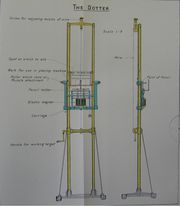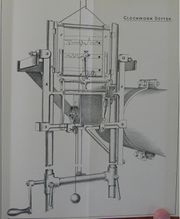Dotter
The Dotter was a training device invented by Percy Scott c. 1900-02[1] to permit gunlayers to practice continuous aim and to measure their success, all without expending ammunition. It became one of the hallmarks of Scott's transformation of Royal Navy gunnery and exemplified how his innovations were often syntheses of drill and equipment.
Its nature and its various configurations are outlined in Manual of Gunnery (Volume III) for His Majesty's Fleet, 1915.[2]
Basic Design

The dotter consisted of a frame in which a small moving ship target moved up and down as a gunnery drill instructor worked a handle or under the influence of a motor. The frame would be positioned ahead of the gun a short distance, and the layer would endeavour to keep the target centered in his scope by working his elevating handwheel. A pencil on a solenoid attached to the gun barrel would plunge forward when the layer pressed his trigger, making a mark on a card.
A pair of horizontal lines on the card represented the limits of acceptable wander in elevation. A perfect job of continuous aim would result in a horizontal series of marks on the card between the drawn lines, despite its up-and-down motion along with the target as the test was run.
Accessories

Some dotters used a clockwork device to automatically advance the pencil laterally as the trial progressed, taking 25, 30 or 35 seconds to traverse the card. When this device was in use, the pencil would continually touch the card and draw a line rather than work under a trigger's action.

Another option was an irregular cam driven by a motor which would systematically simulate a semi-regular rolling action of the ship in the sea. Levers would act to increase the amplitude of motion so that the target card would travel sufficiently far to mimic the possible roll angles.
Use
Minimally, an instructor would work with a man whose task was to cause the card to move to simulate the rolling of the ship. The man moving the card was discouraged from watching the progress of the test, lest he inadvertently bias the result in cases where the nature of the motion was actually under his control. Each use of the trigger would advance the pencil laterally along the card, and when it reached the right edge, the testing would stop momentarily while the card was rearranged vertically to present a new pair of lines to be traced between.
See Also
Footnotes
- ↑ Navy & Army Illustrated, Volume XV No. 295, 27 September, 1902. p. 47.
- ↑ Manual of Gunnery (Volume III) for His Majesty's Fleet, 1915, pp. 135-138.
- ↑ Manual of Gunnery (Volume III) for His Majesty's Fleet, 1915, Plate 1.
- ↑ Manual of Gunnery (Volume III) for His Majesty's Fleet, 1915, Plate 2.
- ↑ Manual of Gunnery (Volume III) for His Majesty's Fleet, 1915, Plate 3.
Bibliography
